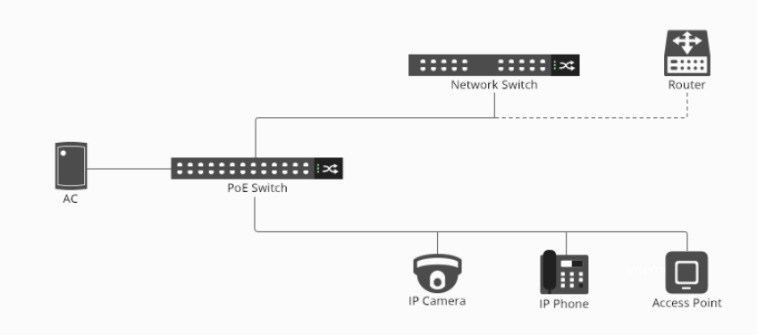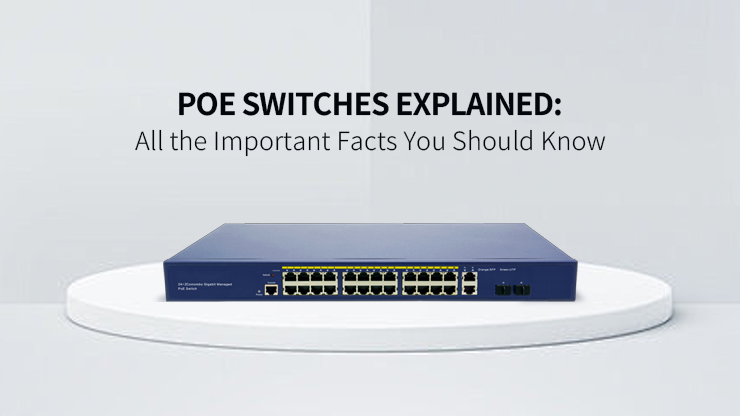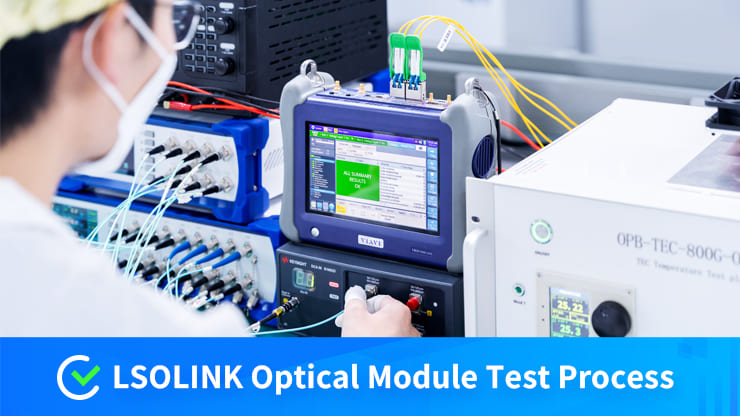PoE Switches Explained: All the Important Facts You Should Know
What is a PoE Switch?
The Basic Definition of a PoE Switch
PoE (Power over Ethernet) is a technology that supports the simultaneous transmission of data and power through Ethernet cables, adhering to international standards such as IEEE 802.3af (15.4W) and 802.3at (30W), ensuring the safety and compatibility of power supply. A PoE switch is a network device that supports the simultaneous transmission of data and power through Ethernet cables, designed to simplify installation and reduce wiring complexity. It can use existing Ethernet to simultaneously transmit data and power to IP terminal devices (such as IP phones, APs, IP cameras, etc.) through network cables, reducing the amount of wiring, facilitating installation and later maintenance.
The Core Advantages of PoE Switches
Compared with traditional Ethernet switches, PoE switches have the following advantages:
1. No additional power wiring required
The PoE switch supplies power and transmits data to the load device through a single Cat6/Cat6A network cable, without the need for additional power wiring. Therefore, during the design of the wiring scheme, the power supply part for the terminal equipment can be omitted, reducing the complexity of wiring and improving the efficiency of later operation and maintenance.
2. Lower installation cost
Since using a PoE switch eliminates the need for additional power wiring, power sockets can also be omitted, saving a significant portion of equipment costs. Moreover, the complexity of wiring is reduced, and the construction cost will also decrease, which can save a large amount of installation costs.
3. Flexible deployment of devices (such as cameras, wireless APs)
The transmission distance of standard network cables is 100 meters, which means it can provide a 100-meter power supply distance. It also breaks through the location restrictions of traditional sockets. Where the network cable goes, the devices can be installed there, increasing the flexibility of device deployment. The devices can also be easily removed when they are not needed.
Common Standards for PoE Switches
Currently, there are mainly three standards for PoE switches: 802.3af (15W), 802.3at (30W), and 802.3bt (90W). Each standard specifies the power capacity for PoE power supply, and these power supply standards are also backward compatible, enhancing the flexibility during usage. The table below presents the detailed information of the three PoE standards.
| Power supply technology | PoE | PoE+ | PoE++ |
| standard name | IEEE.802.3af | IEEE.802.3at | IEEE.802.3bt |
| Power supply distance | 100m | 100m | 100m |
| classification | 0-3 | 0-4 | 0-8 |
| Maximum current | 350mA | 600mA | 1730mA |
| PSE output voltage | 44V-57V DC | 44V-57V DC | 44V-57V DC (Type 3 PSE)52V-57V DC (Type 4 PSE) |
| PSE output power (maximum) | 15.4W | 30W | 60W (Type 3 PSE)90W (Type 4 PSE) |
| PD input voltage | 36V-57V DC | 42V-57V DC | 39.9V-57V DC |
| Maximum power of PD | 12.95W | 25.5W | 51W (Type 3 PSE)71.3W (Type 4 PSE) |
| Cable requirements | / | Cat5e wires of the above specifications | Cat5e wires of the above specifications |
| Power supply line pair | 2 | 2 | 4 |
Key Parameters of PoE Switches
The Power Supply Capacity of the PoE Switch
Now we know that PoE switches have different power supplies depending on their configurations. The power of a single port of the PoE switch is its core parameter, which directly determines whether the terminal devices can be used on the PoE switch. At the same time, the total power budget of the PoE switch is also very important. The total power budget refers to the sum of the power supplies of all ports of the PoE switch. This parameter directly determines how many devices the PoE switch can connect. If the total power of all the power-receiving devices is greater than the total power budget of the PoE switch, it will result in the power-receiving devices not working properly or not working at all.

Network Performance of PoE Switches
PoE switch is a switch that supports PoE function. For a switch, network performance is also an important parameter. The size of the backplane bandwidth and packet forwarding rate determines its data processing rate. If a switch with insufficient network performance is selected, it will cause network congestion, resulting in an unpleasant online and usage experience.
Security Protection for PoE Switches
PoE switches are usually connected to terminal devices, such as IP cameras, APs, etc. Some of these devices are used in outdoor open-air environments, exposed to wind, sun, rain, and other harsh conditions. After long-term use, there is a possibility of short circuits, overloads, lightning strikes and other unexpected natural disasters, which can cause damage to the terminal devices and affect the PoE switch, resulting in network interruption or damage to the switch. Therefore, the safety protection function of PoE switches is indispensable. Overload protection, short circuit protection, and lightning protection design are the most basic safety protection measures. These protections enable us to use the switch more safely.
Typical Application Scenarios of PoE Switches
Security Monitoring System
The security monitoring system is one of the typical application scenarios for PoE switches. In the security monitoring system, PoE switches can supply power and transmit data for multiple cameras, significantly simplifying the complexity of wiring and reducing the deployment cost by over 45%. Some advanced PoE switches also have functions such as intelligent power management support, remote device control, automatic fault isolation, and multi-level energy efficiency optimization, which can ensure the reliable operation of cameras in extreme environments, achieve efficient deployment, centralized operation and maintenance, and flexible expansion of the monitoring system. It is one of the core components of the security monitoring system.
Enterprise Wireless Network
Enterprise wireless networks are also one of the typical application scenarios for PoE switches. In enterprise wireless networks, PoE switches provide stable power supply and data transmission for wireless APs, eliminating the limitations on the installation locations of APs, simplifying ceiling wiring, making the wiring more efficient and aesthetically pleasing. When combined with AC devices, they can manage multiple connected APs simultaneously, ensuring the stable operation of the wireless network. It is one of the core components of enterprise wireless networks.
Intelligent Office
Intelligent office is also one of the typical application scenarios of PoE switches. In the intelligent office network, PoE switches provide both data and power support simultaneously for wireless APs, IP phones, intelligent lighting, security sensors, and video conferencing terminals through network cables, without the need for independent power wiring, saving more than 30% of deployment costs. Ensuring the stability of the office network; The regular gigabit/10-gigabit bandwidth of PoE switches can meet the high traffic and low latency requirements of high-definition video conferences and remote real-time office work. The 100-meter wiring distance can be flexibly expanded to accommodate workstation layouts, helping to build an efficient, energy-saving, centralized control, and adaptable to future upgrades intelligent office environment. It is one of the core components of the intelligent office network.

Advantages of the LSOLINK 48-Port PoE Switch

48 PoE+ Ports Offer Support for High-Density Deployment
The S3000 series PoE switch of LSOLINK, model S3000M-48TP4S, can provide up to 48 PoE+ ports, which can meet the requirements of high-density access. Each port can provide a maximum power supply of 30W, and the entire machine can provide a maximum total power supply of 450W, which can meet the power supply needs of terminal devices such as APs, cameras, and IP phones. Moreover, the S3000M-48TP4S is equipped with a dual-fan active cooling system, which can ensure the stable operation of the switch in scenarios with poor heat dissipation or high load.
Superior Network Performance Offers an Excellent Online Experience
The PoE switch S3000M-48TP4S of LSOLINK has a 256Gbps switching capacity and a 77.38Mpps packet forwarding rate. It can significantly avoid congestion during traffic transmission. With 32K MAC addresses and a 16Mbit large cache, video forwarding is smoother, reducing video lag and ghosting. It supports IPv6, IGMP Snooping, VLAN division, QoS, traffic control, link aggregation, 802.1x and other Layer 2 functions. Users can configure the switch according to different network usage requirements to enhance the network experience. Moreover, it supports console and WEB interface management and configuration, making it convenient for operation and maintenance and allowing real-time monitoring of the switch’s working status.
Frequently Asked Questions Answered
Q: Is there a limit to the power supply distance of PoE switches?
A: The power supply distance of PoE switches is the same as that of network cables. The standard transmission distance is 100 meters. For distances exceeding 100 meters, extenders or repeaters are required.
Q: Can a regular switch be converted to a PoE device?
A: A regular switch does not support the PoE function. However, the PoE power supply function can be achieved through a PoE injector. However, this combination has poor stability and the PoE injector requires an additional power socket.
Q: How can one determine if a switch supports PoE?
A: The detailed interface when purchasing the switch will indicate “PoE switch”, and the switch datasheet will also provide detailed explanations. During use, you can check the front panel of the switch. The ports of the switch that support PoE will be marked with the word “PoE”.
Q: How can one determine the power requirement of the PoE switch?
A: This can be determined by considering the overall power supply of the switch’s PoE ports and the operating power of the switch. As long as the power supply is greater than the sum of the overall power supply of the switch’s PoE ports and the operating power of the switch, it is acceptable.
Q: How can we determine how many power-consuming devices can be connected to a PoE switch?
A: The number of devices that can be connected to the switch depends on the total power budget of the switch and the PoE protocol supported by the power-consuming devices. For example, for the LSOLINK PoE switch S3000M-48TP4S, if 15W IEEE.802.3af devices are connected, it can accommodate 30 devices and provide stable power supply for them; if 30W IEEE.802.3at devices are connected, it can accommodate 15 devices and provide stable power supply for them.








